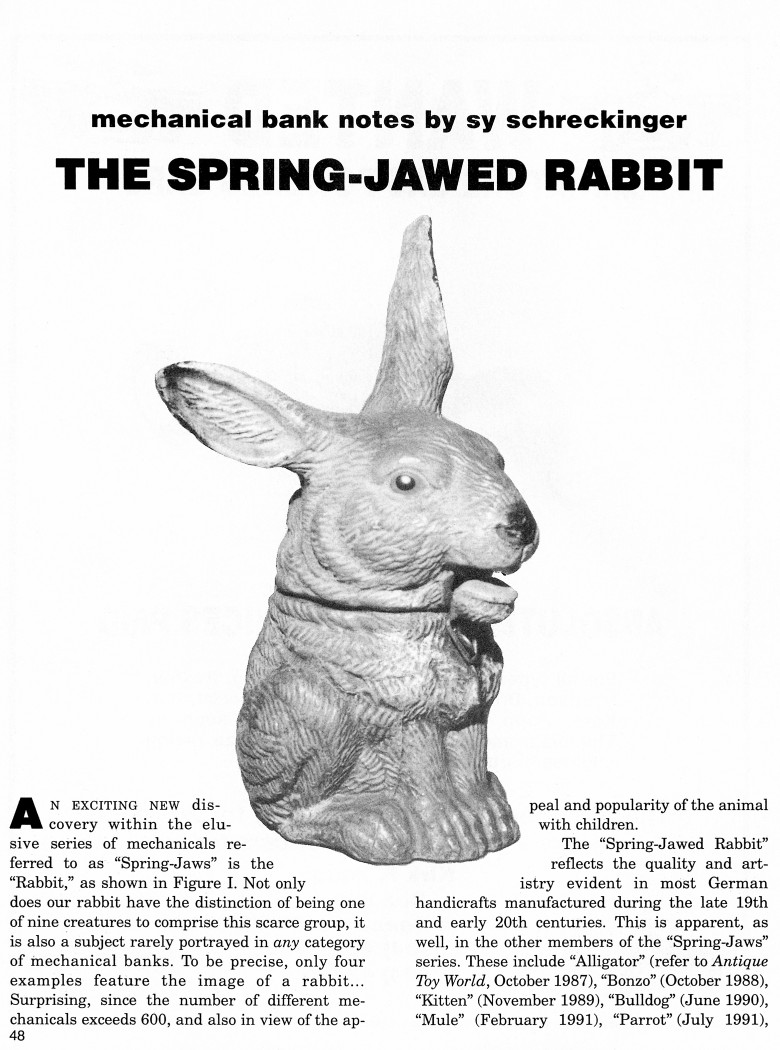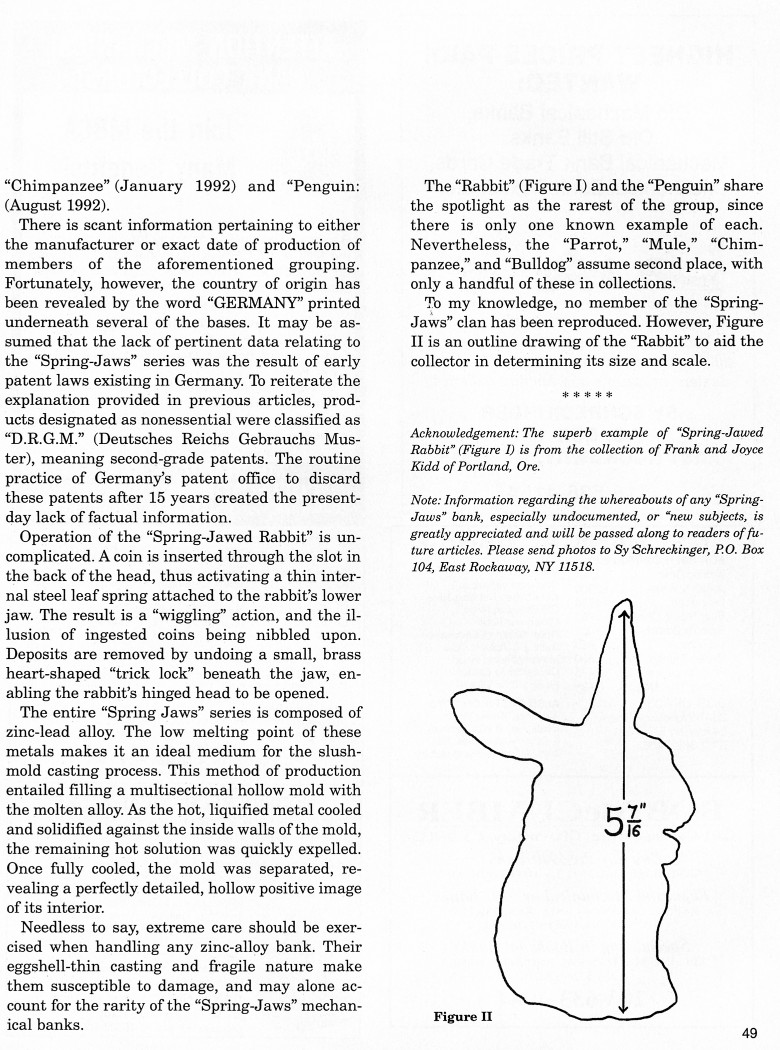|
The Spring-Jawed Rabbit
by Sy Schreckinger – ANTIQUE TOY WORLD Magazine – September, 1996
An exciting new discovery within the elusive
series of mechanicals referred to as "Spring-Jaws" is the "Rabbit," as
shown in Figure I. Not only does our rabbit have the distinction of being
one of nine creatures to comprise this scarce group, it is also a subject
rarely portrayed in any category of mechanical banks. To be precise, only
four examples feature the image of a rabbit... Surprising, since the
number of different mechanicals exceeds 600, and also in view of the
appeal and popularity of the animal with children.
The "Spring-Jawed Rabbit" reflects the quality and artistry evident
in most German handicrafts manufactured during the late 19th
and early 20th centuries. This is apparent, as well, in the other members
of the "Spring-Jaws" series. These include "Alligator" (refer to Antique
Toy World, October 1987), "Bonzo" (October 1988), "Kitten" (November
1989), "Bulldog" (June 1990), "Mule" (February 1991), "Parrot" (July
1991), "Chimpanzee" (January 1992) and "Penguin: (August 1992).
There is scant information pertaining to either the manufacturer or
exact date of production of members of the aforementioned grouping.
Fortunately, however, the country of origin has been revealed by the word
"GERMANY" printed underneath several of the bases. It may be assumed that
the lack of pertinent data relating to the "Spring-Jaws" series was the
result of early patent laws existing in Germany. To reiterate the
explanation provided in previous articles, products designated as
nonessential were classified as "D.R.G.M." (Deutsches Reichs Gebrauchs
Muster), meaning second-grade patents. The routine practice of Germany's
patent office to discard these patents after 15 years created the present-day lack of factual information.
Operation of the "Spring-Jawed Rabbit" is uncomplicated. A coin is
inserted through the slot in the back of the head, thus activating a thin
internal steel leaf spring attached to the rabbit's lower jaw. The result
is a "wiggling" action, and the illusion of ingested coins being nibbled
upon. Deposits are removed by undoing a small, brass heart-shaped "trick
lock" beneath the jaw, enabling the rabbit's hinged head to be opened.
The entire "Spring Jaws" series is composed of zinc-lead alloy. The
low melting point of these metals makes it an ideal medium for the
slush-mold casting process. This method of production entailed filling a
multi-sectional hollow mold with the molten alloy. As the hot, liquefied
metal cooled and solidified against the inside walls of the mold, the
remaining hot solution was quickly expelled. Once fully cooled, the mold
was separated, revealing a perfectly detailed, hollow positive image of
its interior.
Needless to say, extreme care should be exercised when handling any
zinc-alloy bank. Their eggshell-thin casting and fragile nature make them
susceptible to damage, and may alone account for the rarity of the
"Spring-Jaws" mechanical banks.
The "Rabbit" (Figure I) and the "Penguin" share the spotlight as the
rarest of the group, since there is only one known example of each.
Nevertheless, the "Parrot," "Mule," "Chimpanzee," and "Bulldog" assume
second place, with only a handful of these in collections.
To my knowledge, no member of the "Spring- Jaws" clan has been
reproduced. However, Figure II is an outline drawing of the "Rabbit" to
aid the collector in determining its size and scale.
Acknowledgement: The superb example of "Spring-Jawed Rabbit" (Figure
I) is from the collection of Frank and Joyce Kidd of Portland, Ore.
Note: Information regarding the whereabouts of any "Spring- Jaws"
bank, especially undocumented, or "new subjects, is greatly appreciated
and will be passed along to readers of future articles. Please send photos
to Sy Schreckinger, P.O. Box 104, East Rockaway, NY 11518.
Omissions: (from
November, 1996) (1) Operating instructions for the
"Mason Bank" (refer to Antique Toy World,
September 1996) were erroneously
omitted: The rabbit is an overall dark reddish brown, with tan and white
highlights. The tips of its ears and nose are black, and it has light tan
eyes with black pupils. The inside of its mouth is pink, and it has two
white teeth.
Correction: (from
January, 1997) Descriptive colors of the "Spring Jawed Rabbit" (Antique Toy
World, September 1996) were erroneously omitted: The rabbit is an overall
dark reddish brown, with tan and white highlights. The tips of its ears
and its nose are black, and it has light tan eyes with black pupils. The
inside of its mouth is pink, and it has two white teeth.
|


